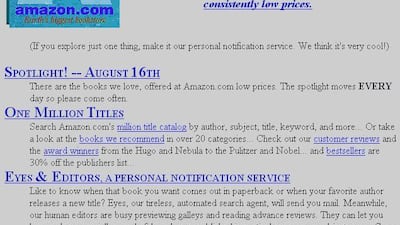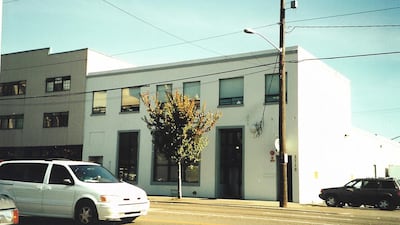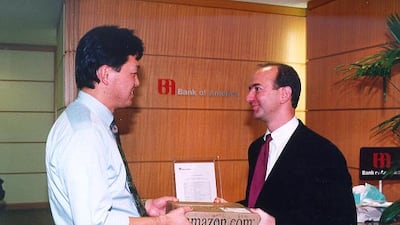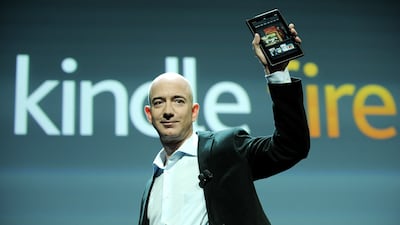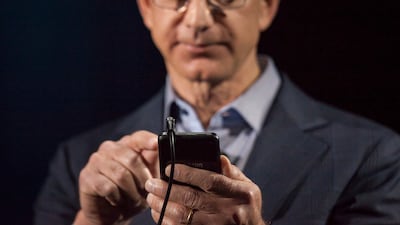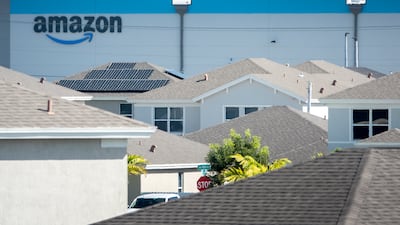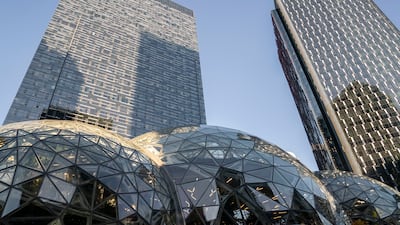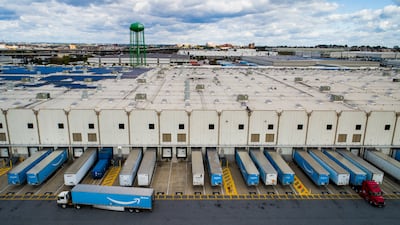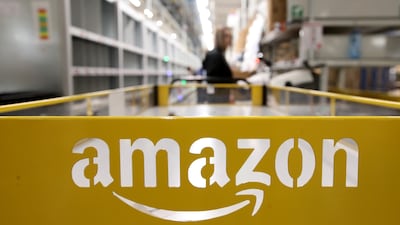In 1994, the terms “online shopping” and “e-commerce” were hardly a thing. Two of the most notable websites for such services were Boston Computer Exchange, the world's first e-commerce site that sold PCs, and Book Stacks Unlimited, the first online bookstore. You may never have heard of them.
And even fewer people could access them: only 11 million households in the US, the world's most advanced economy, had modem-enabled PCs that year, the Pew Research Centre said in a 1995 report. That's only a shade above 11 per cent of all households in America.
Also, mobile phones were still in their most basic iterations, so access to the internet, with only about 10,000 websites in 1994, was not as omnipresent as it is today.
However, that hard-to-reach internet was where a 30-year-old vice president of a New York investment management firm would get the light bulb moment to lay the foundations for Amazon, one of the most influential and dominant companies in history.
That 30-year-old, Jeffrey Preston Bezos, discovered online that usage of the World Wide Web was growing by 2,300 per cent annually.
Thirty years ago, the retail landscape looked very different. Without Amazon – arguably the industry's biggest influencer – the growth and adoption of e-commerce might not have evolved to what we know today.
Amazon officially opened for business on July 16, 1995. But its seeds were planted more than a year earlier, 30 years ago to this day.
“Amazon has been an accelerator and a driver for innovation in the retail industry at large,” Filippo Battaini, a research manager at the International Data Corporation, told The National.
“There would have been slower developments of retail innovations, such as one-click ordering, comprehensive customer reviews and personalised recommendations” and “much less advancement in areas including logistics, alternative business models and revenue streams”, he said.
Jeff 'booked' it
Amazon sprouted from humble beginnings, being founded in a Bellevue, Washington garage rented by Mr Bezos and his colleague and then-wife, MacKenzie Scott. The couple divorced in 2021.
Before those early days of operations, on July 5, 1994, Mr Bezos incorporated his company in Washington state under the name Cadabra Inc. However, he was convinced to change that, after his lawyer misheard that name as “cadaver”.
He settled on Amazon, one of the world's largest rivers, as a nod to his ambitions to grow the company into “the everything store” (the arrow on the Amazon logo points from “a” to “z”).
After combing through potential products he could sell online, Mr Bezos came up with a shortlist and settled on books – since, in his words, there were three million of them in comparison to about 200,000 active music CDs.
“Books were great … because books are incredibly unusual in one respect, that is that there are more items in the book category than there are items in any other category by far,” he said in an interview at the Special Libraries Conference in June 1997.
“When you have that many items you can literally build a store online that couldn’t exist any other way.”
The very first item ever sold on Amazon was Fluid Concepts and Creative Analogies: Computer Models of the Fundamental Mechanisms of Thought, a 1995 book by Douglas Hofstadter and his co-members at the Fluid Analogies Research Group.
The book – on artificial intelligence, no less – was bought by John Wainwright, an Australian computer scientist based in California.

To honour his contribution, Amazon named one of the office buildings on its campus after Mr Wainwright. Not bad for a $27.95 online purchase.
The numbers gain
As Amazon grew, so did Mr Bezos's confidence in the market and the future of online retail. Amazon went public in 1997 at $18 a share – a figure that has grown about 1,000 per cent. Its highest closing price was $197.85 – reached on June 27.
The company, which claimed to be the “Earths' biggest bookstore”, gradually expanded.
In 1998, Amazon made a splash with its first acquisitions – the trio of UK online bookstore Bookpages, Germany's Telebook and the Internet Movie Database (IMDb).
The company began selling CDs and DVDs in the same year, while expanding into more product categories, including consumer electronics, games and video games.
In 2000, Amazon introduced Marketplace, which allowed people to sell on its website and positioned it to compete with the then five-year-old eBay.
In Amazon's company report for that year, it said it served 20 million customers and posted $2.76 billion in sales.
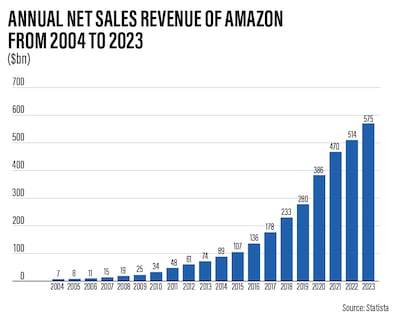
Today, Amazon is estimated to have around 310 million active users globally, including more than 200 million Prime subscribers, and has more than 600 million products in its marketplace, according to data gathered by AMZScout, a platform that helps sellers on Amazon.
In 2023, the company reported net sales of $574.8 billion – that's about $1.57 billion per day, nearly $66 million per hour, or more than $18,000 per second.
“Amazon’s journey from a small online bookseller to one of the global giants today saw its ups and downs in the beginning, but their commitment to innovation led them to be one of the most successful companies in the world today,” the Michigan Journal of Economics wrote in May 2023.
Prime time
The year 2002 saw the formation of the unit that would become Amazon Web Services, which opened the Amazon.com platform to all developers. With the cloud unit following in 2006, this marked the company's foray into IT services, including cloud, data and AI.
A year later, Amazon would achieve another milestone: it turned in an annual profit of $75 million, the first time it finished a year in the black. The company peaked in 2021 when it reported a net income of nearly $33.4 billion. Last year, its profit hit $30.4 billion.
Only three more times it would finish in the red – in 2012, 2014 and 2022, posting net losses of $39 million, $241 million and $2.72 billion, respectively.
Another pivotal launch came in 2005 with Amazon Prime, its first subscription service that initially offered US customers free two-day shipping for $79 a year.
However, reception to Prime was initially lukewarm for two reasons: online shopping was a relatively new concept and, more importantly, people found its price tag high.
Amazon slowly convinced users by bundling add-ons to the service, starting out with Prime Video in 2006 and, notably, rolling out Prime Day in 2015, where subscribers are offered exclusive deals on the website.
Prime Day started out as a 24-hour bonanza, but later moved to a two-day event. This year, Prime Day in the UAE will run for six days, from July 16 to 21.
“We saw some changes in UAE shopping behaviour … [customers] do look more and more to coupons, discount sales and overall value,” Stefano Martinelli, vice president of Amazon in the UAE and Saudi Arabia, told The National on Wednesday.
“Prime customer engagement is increasing year-over-year,” he said.
“This year we probably have the widest deal spectrum because we basically want customers to choose what they want.”
Amazon later also expanded into hardware, creating products such as the Kindle e-reader, the Fire TV and Amazon Echo, which introduced Siri's rival, Alexa. Of course, not all would pan out, particularly with the Fire Phone, which was deemed a commercial failure.
Its largest acquisition – the $13.7 billion purchase of Whole Foods in 2017 – marked its entry into the highly competitive grocery market.
The same year, the company shook up the UAE's e-commerce industry by buying Dubai-based Souq.com for $680 million.
Fast-forward to 2018 and Amazon reached another milestone: its market capitalisation crossed $1 trillion, making it, at the time, only the third company to hit that mark.
The success of Amazon also boosted the fortune of Mr Bezos, who ranks among the top three billionaires in the world.
Mr Bezos stepped down as Amazon chief executive in 2021, handing over to erstwhile AWS chief executive Andy Jassy.
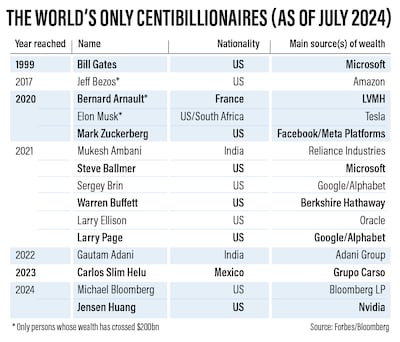
Making the connection
Amazon has shaken up the e-commerce industry and through its “innovative business models, it was able to strengthen shopper loyalty”, IDC's Mr Battaini said.
It's not all rosy though: Amazon has been hit with accusations of workplace malpractice, anti-competitive schemes and tax avoidance. Its model also forced established brick-and-mortar stores, who failed to keep up, to close some – if not all – of their outlets.
“Competitors were pushed to innovate and invest more in technology to catch up [with Amazon],” Mr Battaini said.
“Legacy retailers that responded successfully to Amazon’s competitive pressure are those that managed to combine effective digital transformation with the advantage of their physical store network, such as Walmart.”
Amazon is expected to continue advancing its logistics and technology, especially with the boom in artificial intelligence.
That would allow it to improve personalisation, predictive analytics and customer service automation, Mr Battaini said.
The chances are, most people have used Amazon services or products. And it doesn't look like the juggernaut is toning down its sales pitch any time soon.
